Informatics and Financial Applications in the Retail Sector Analysis
VerifiedAdded on 2020/02/24
|8
|1605
|84
Report
AI Summary
This report provides an overview of informatics and financial applications within the retail industry. It explores the use of Decision Support Systems (DSS) in analyzing market trends, predicting sales, and supporting marketing strategies. The report also examines the implementation of Cloud Computing (CC) in retail, highlighting its cost-saving benefits, and how it facilitates online services and business innovation. The report concludes by emphasizing the importance of Information Technology (IT) as a mandatory component for business success in the retail sector, enabling efficient resource deployment and providing mobile and flexible platforms. References to relevant academic sources are also included.
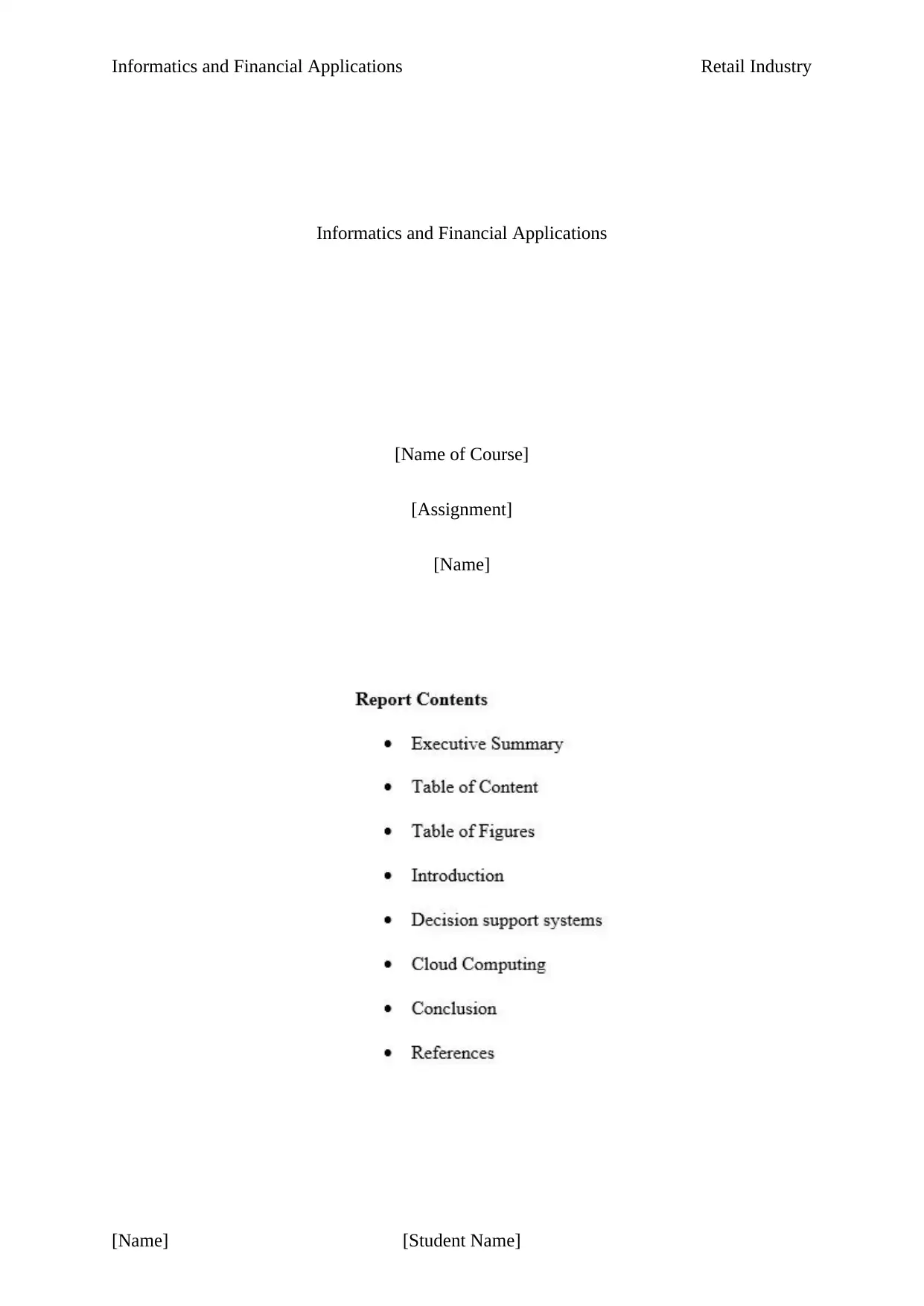
Informatics and Financial Applications Retail Industry
Informatics and Financial Applications
[Name of Course]
[Assignment]
[Name]
[Name] [Student Name]
Informatics and Financial Applications
[Name of Course]
[Assignment]
[Name]
[Name] [Student Name]
Paraphrase This Document
Need a fresh take? Get an instant paraphrase of this document with our AI Paraphraser
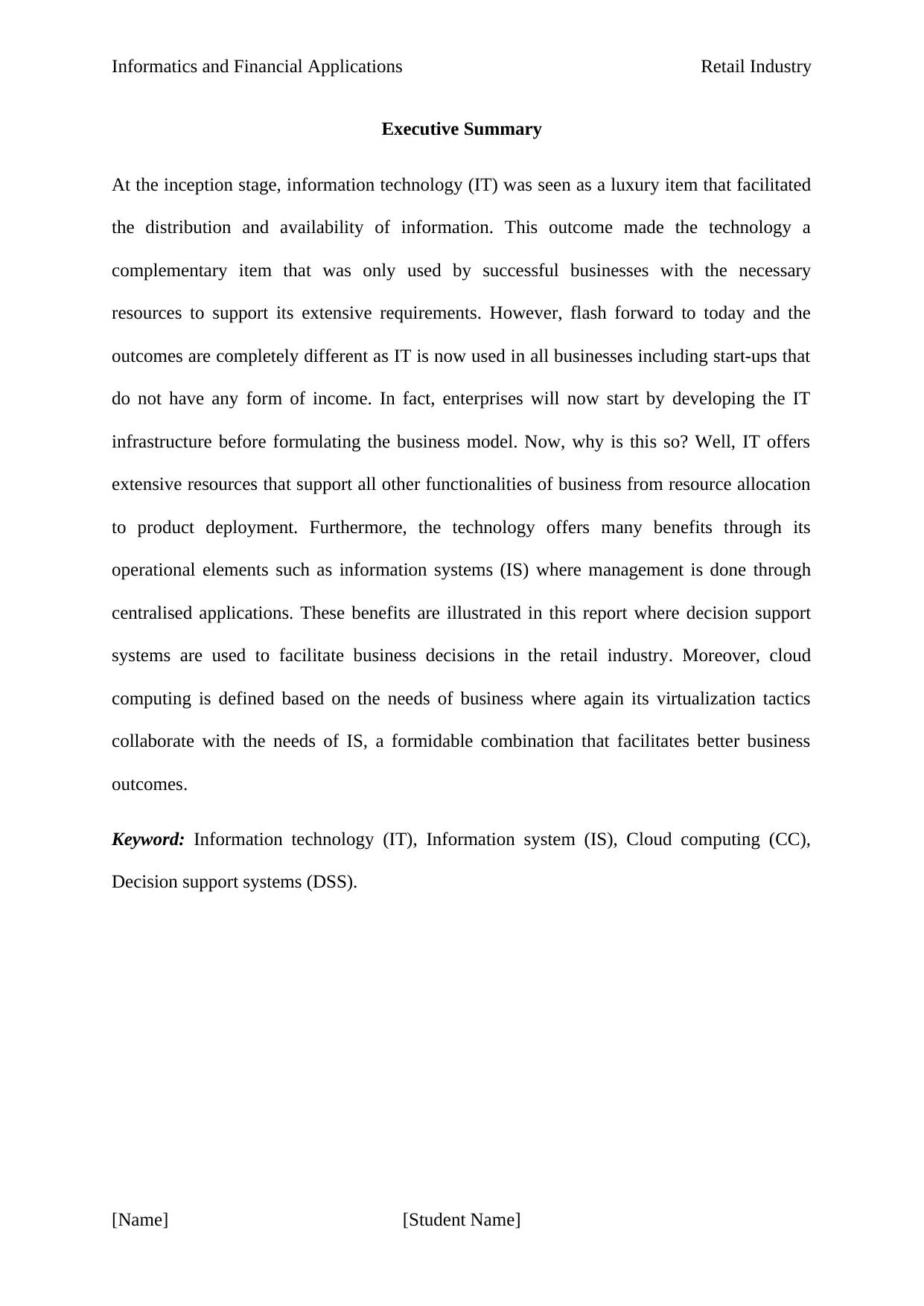
Informatics and Financial Applications Retail Industry
Executive Summary
At the inception stage, information technology (IT) was seen as a luxury item that facilitated
the distribution and availability of information. This outcome made the technology a
complementary item that was only used by successful businesses with the necessary
resources to support its extensive requirements. However, flash forward to today and the
outcomes are completely different as IT is now used in all businesses including start-ups that
do not have any form of income. In fact, enterprises will now start by developing the IT
infrastructure before formulating the business model. Now, why is this so? Well, IT offers
extensive resources that support all other functionalities of business from resource allocation
to product deployment. Furthermore, the technology offers many benefits through its
operational elements such as information systems (IS) where management is done through
centralised applications. These benefits are illustrated in this report where decision support
systems are used to facilitate business decisions in the retail industry. Moreover, cloud
computing is defined based on the needs of business where again its virtualization tactics
collaborate with the needs of IS, a formidable combination that facilitates better business
outcomes.
Keyword: Information technology (IT), Information system (IS), Cloud computing (CC),
Decision support systems (DSS).
[Name] [Student Name]
Executive Summary
At the inception stage, information technology (IT) was seen as a luxury item that facilitated
the distribution and availability of information. This outcome made the technology a
complementary item that was only used by successful businesses with the necessary
resources to support its extensive requirements. However, flash forward to today and the
outcomes are completely different as IT is now used in all businesses including start-ups that
do not have any form of income. In fact, enterprises will now start by developing the IT
infrastructure before formulating the business model. Now, why is this so? Well, IT offers
extensive resources that support all other functionalities of business from resource allocation
to product deployment. Furthermore, the technology offers many benefits through its
operational elements such as information systems (IS) where management is done through
centralised applications. These benefits are illustrated in this report where decision support
systems are used to facilitate business decisions in the retail industry. Moreover, cloud
computing is defined based on the needs of business where again its virtualization tactics
collaborate with the needs of IS, a formidable combination that facilitates better business
outcomes.
Keyword: Information technology (IT), Information system (IS), Cloud computing (CC),
Decision support systems (DSS).
[Name] [Student Name]
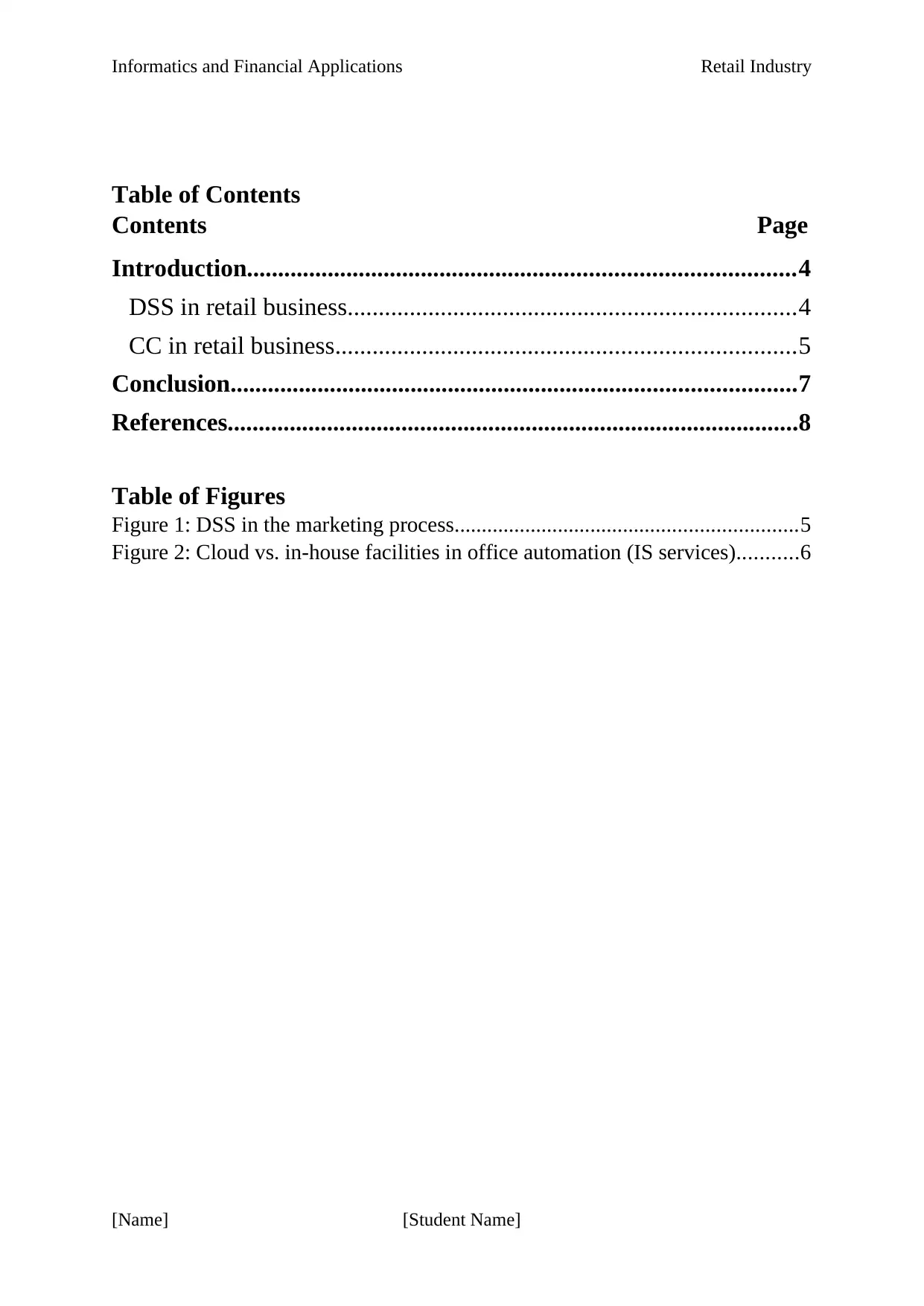
Informatics and Financial Applications Retail Industry
Table of Contents
Contents Page
Introduction........................................................................................4
DSS in retail business........................................................................4
CC in retail business..........................................................................5
Conclusion...........................................................................................7
References............................................................................................8
Table of Figures
Figure 1: DSS in the marketing process...............................................................5
Figure 2: Cloud vs. in-house facilities in office automation (IS services)...........6
[Name] [Student Name]
Table of Contents
Contents Page
Introduction........................................................................................4
DSS in retail business........................................................................4
CC in retail business..........................................................................5
Conclusion...........................................................................................7
References............................................................................................8
Table of Figures
Figure 1: DSS in the marketing process...............................................................5
Figure 2: Cloud vs. in-house facilities in office automation (IS services)...........6
[Name] [Student Name]
⊘ This is a preview!⊘
Do you want full access?
Subscribe today to unlock all pages.

Trusted by 1+ million students worldwide
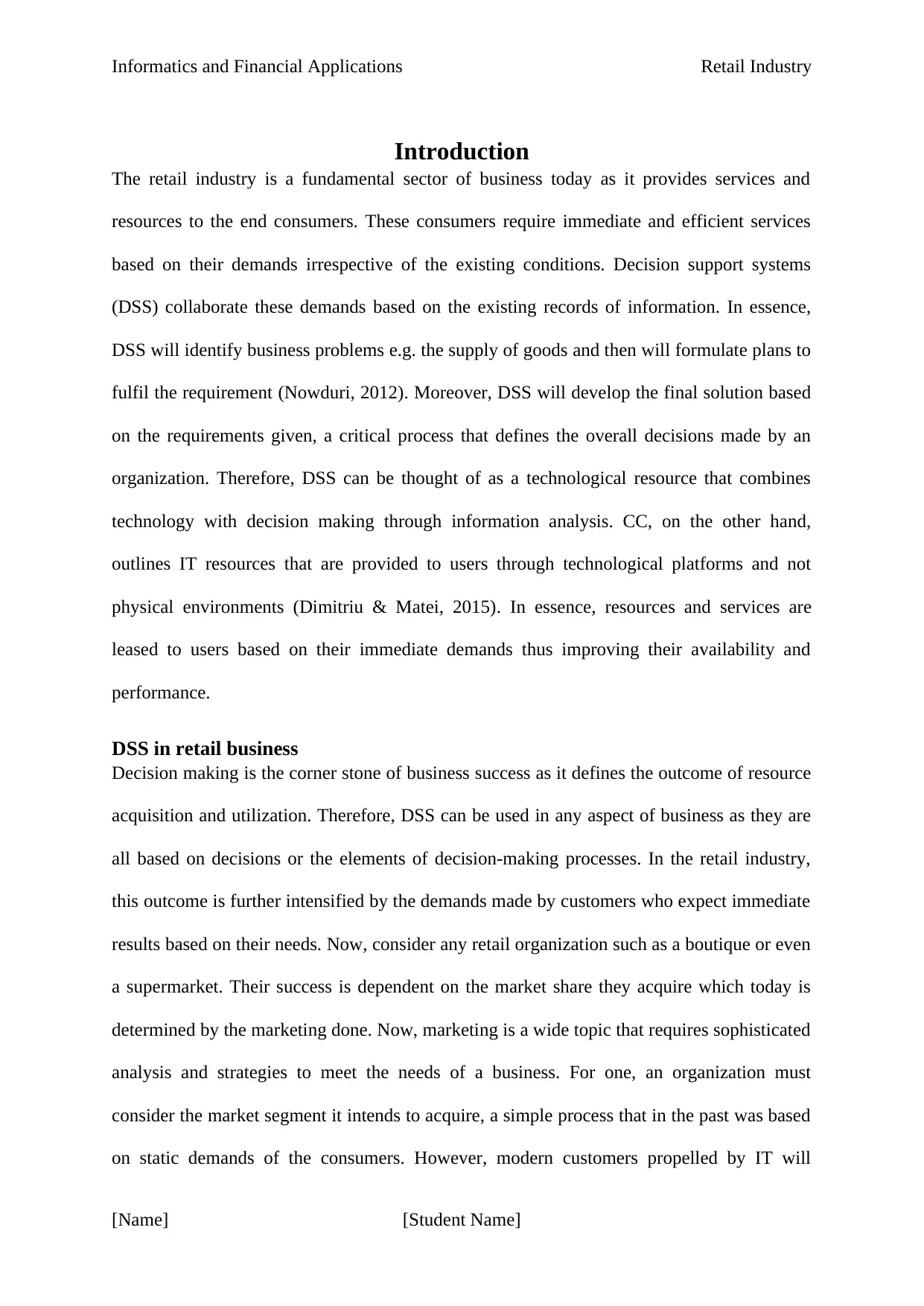
Informatics and Financial Applications Retail Industry
Introduction
The retail industry is a fundamental sector of business today as it provides services and
resources to the end consumers. These consumers require immediate and efficient services
based on their demands irrespective of the existing conditions. Decision support systems
(DSS) collaborate these demands based on the existing records of information. In essence,
DSS will identify business problems e.g. the supply of goods and then will formulate plans to
fulfil the requirement (Nowduri, 2012). Moreover, DSS will develop the final solution based
on the requirements given, a critical process that defines the overall decisions made by an
organization. Therefore, DSS can be thought of as a technological resource that combines
technology with decision making through information analysis. CC, on the other hand,
outlines IT resources that are provided to users through technological platforms and not
physical environments (Dimitriu & Matei, 2015). In essence, resources and services are
leased to users based on their immediate demands thus improving their availability and
performance.
DSS in retail business
Decision making is the corner stone of business success as it defines the outcome of resource
acquisition and utilization. Therefore, DSS can be used in any aspect of business as they are
all based on decisions or the elements of decision-making processes. In the retail industry,
this outcome is further intensified by the demands made by customers who expect immediate
results based on their needs. Now, consider any retail organization such as a boutique or even
a supermarket. Their success is dependent on the market share they acquire which today is
determined by the marketing done. Now, marketing is a wide topic that requires sophisticated
analysis and strategies to meet the needs of a business. For one, an organization must
consider the market segment it intends to acquire, a simple process that in the past was based
on static demands of the consumers. However, modern customers propelled by IT will
[Name] [Student Name]
Introduction
The retail industry is a fundamental sector of business today as it provides services and
resources to the end consumers. These consumers require immediate and efficient services
based on their demands irrespective of the existing conditions. Decision support systems
(DSS) collaborate these demands based on the existing records of information. In essence,
DSS will identify business problems e.g. the supply of goods and then will formulate plans to
fulfil the requirement (Nowduri, 2012). Moreover, DSS will develop the final solution based
on the requirements given, a critical process that defines the overall decisions made by an
organization. Therefore, DSS can be thought of as a technological resource that combines
technology with decision making through information analysis. CC, on the other hand,
outlines IT resources that are provided to users through technological platforms and not
physical environments (Dimitriu & Matei, 2015). In essence, resources and services are
leased to users based on their immediate demands thus improving their availability and
performance.
DSS in retail business
Decision making is the corner stone of business success as it defines the outcome of resource
acquisition and utilization. Therefore, DSS can be used in any aspect of business as they are
all based on decisions or the elements of decision-making processes. In the retail industry,
this outcome is further intensified by the demands made by customers who expect immediate
results based on their needs. Now, consider any retail organization such as a boutique or even
a supermarket. Their success is dependent on the market share they acquire which today is
determined by the marketing done. Now, marketing is a wide topic that requires sophisticated
analysis and strategies to meet the needs of a business. For one, an organization must
consider the market segment it intends to acquire, a simple process that in the past was based
on static demands of the consumers. However, modern customers propelled by IT will
[Name] [Student Name]
Paraphrase This Document
Need a fresh take? Get an instant paraphrase of this document with our AI Paraphraser
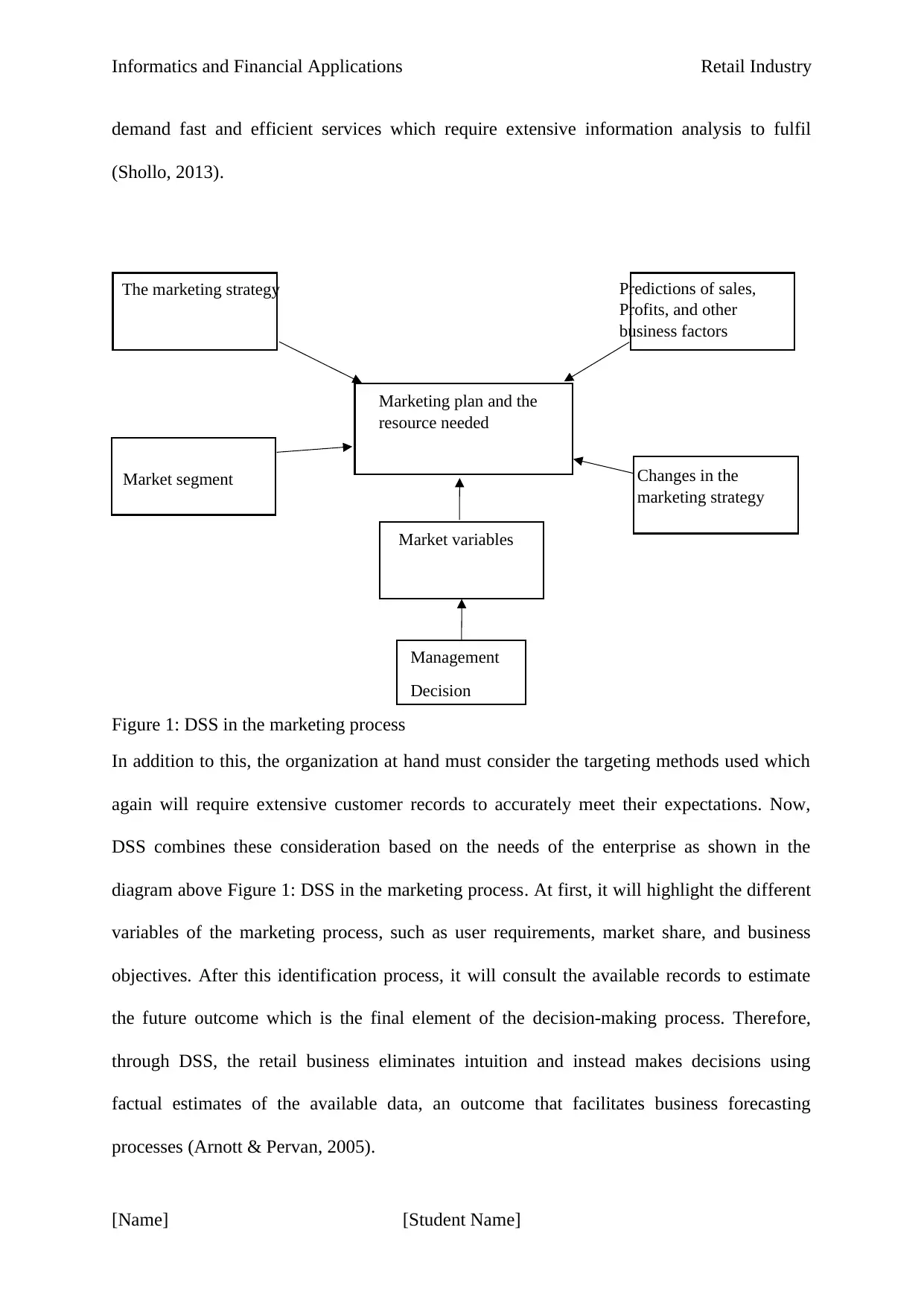
Informatics and Financial Applications Retail Industry
demand fast and efficient services which require extensive information analysis to fulfil
(Shollo, 2013).
Figure 1: DSS in the marketing process
In addition to this, the organization at hand must consider the targeting methods used which
again will require extensive customer records to accurately meet their expectations. Now,
DSS combines these consideration based on the needs of the enterprise as shown in the
diagram above Figure 1: DSS in the marketing process. At first, it will highlight the different
variables of the marketing process, such as user requirements, market share, and business
objectives. After this identification process, it will consult the available records to estimate
the future outcome which is the final element of the decision-making process. Therefore,
through DSS, the retail business eliminates intuition and instead makes decisions using
factual estimates of the available data, an outcome that facilitates business forecasting
processes (Arnott & Pervan, 2005).
[Name] [Student Name]
Predictions of sales,
Profits, and other
business factors
The marketing strategy
Marketing plan and the
resource needed
Market segment Changes in the
marketing strategy
Market variables
Management
Decision
demand fast and efficient services which require extensive information analysis to fulfil
(Shollo, 2013).
Figure 1: DSS in the marketing process
In addition to this, the organization at hand must consider the targeting methods used which
again will require extensive customer records to accurately meet their expectations. Now,
DSS combines these consideration based on the needs of the enterprise as shown in the
diagram above Figure 1: DSS in the marketing process. At first, it will highlight the different
variables of the marketing process, such as user requirements, market share, and business
objectives. After this identification process, it will consult the available records to estimate
the future outcome which is the final element of the decision-making process. Therefore,
through DSS, the retail business eliminates intuition and instead makes decisions using
factual estimates of the available data, an outcome that facilitates business forecasting
processes (Arnott & Pervan, 2005).
[Name] [Student Name]
Predictions of sales,
Profits, and other
business factors
The marketing strategy
Marketing plan and the
resource needed
Market segment Changes in the
marketing strategy
Market variables
Management
Decision
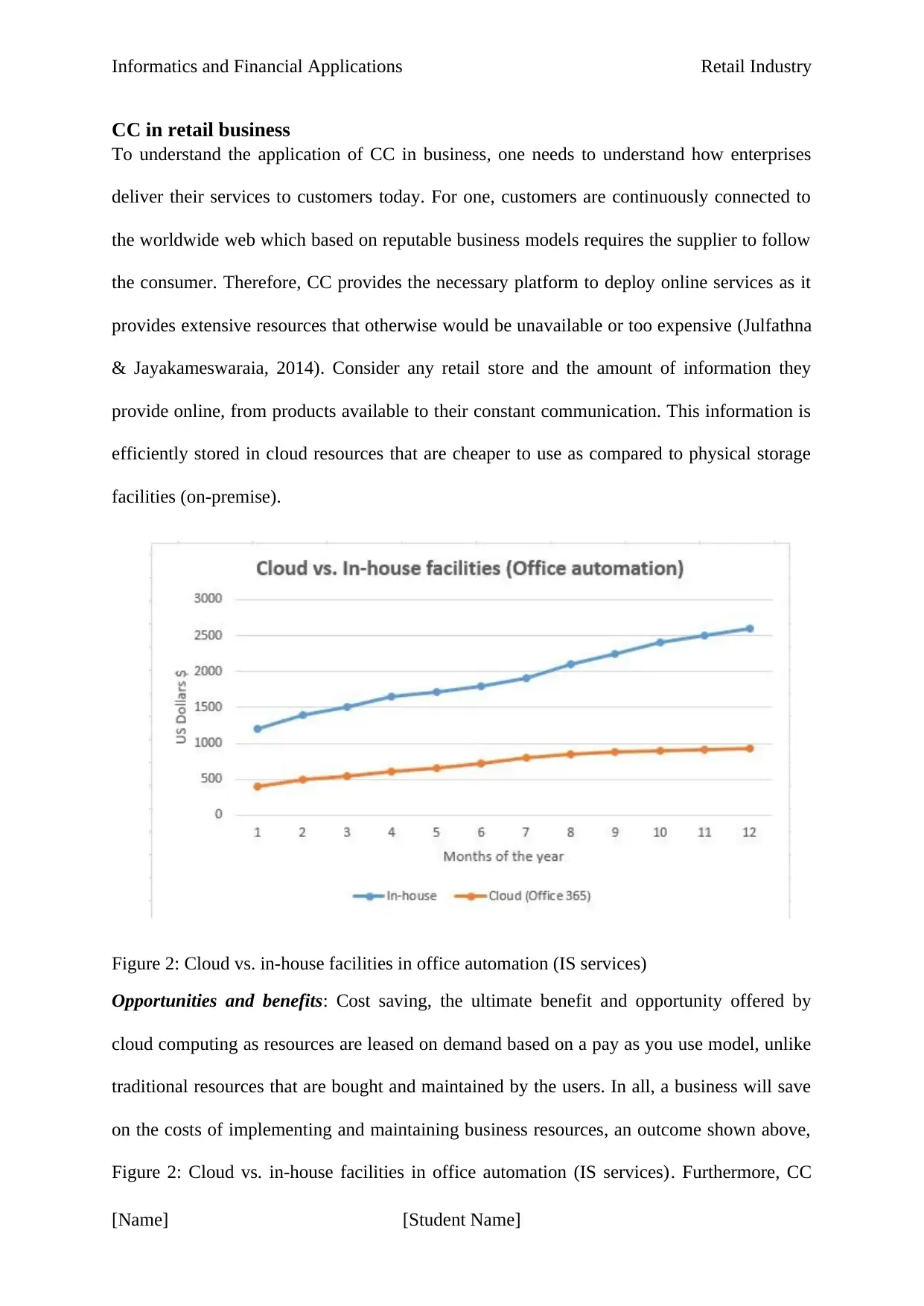
Informatics and Financial Applications Retail Industry
CC in retail business
To understand the application of CC in business, one needs to understand how enterprises
deliver their services to customers today. For one, customers are continuously connected to
the worldwide web which based on reputable business models requires the supplier to follow
the consumer. Therefore, CC provides the necessary platform to deploy online services as it
provides extensive resources that otherwise would be unavailable or too expensive (Julfathna
& Jayakameswaraia, 2014). Consider any retail store and the amount of information they
provide online, from products available to their constant communication. This information is
efficiently stored in cloud resources that are cheaper to use as compared to physical storage
facilities (on-premise).
Figure 2: Cloud vs. in-house facilities in office automation (IS services)
Opportunities and benefits: Cost saving, the ultimate benefit and opportunity offered by
cloud computing as resources are leased on demand based on a pay as you use model, unlike
traditional resources that are bought and maintained by the users. In all, a business will save
on the costs of implementing and maintaining business resources, an outcome shown above,
Figure 2: Cloud vs. in-house facilities in office automation (IS services). Furthermore, CC
[Name] [Student Name]
CC in retail business
To understand the application of CC in business, one needs to understand how enterprises
deliver their services to customers today. For one, customers are continuously connected to
the worldwide web which based on reputable business models requires the supplier to follow
the consumer. Therefore, CC provides the necessary platform to deploy online services as it
provides extensive resources that otherwise would be unavailable or too expensive (Julfathna
& Jayakameswaraia, 2014). Consider any retail store and the amount of information they
provide online, from products available to their constant communication. This information is
efficiently stored in cloud resources that are cheaper to use as compared to physical storage
facilities (on-premise).
Figure 2: Cloud vs. in-house facilities in office automation (IS services)
Opportunities and benefits: Cost saving, the ultimate benefit and opportunity offered by
cloud computing as resources are leased on demand based on a pay as you use model, unlike
traditional resources that are bought and maintained by the users. In all, a business will save
on the costs of implementing and maintaining business resources, an outcome shown above,
Figure 2: Cloud vs. in-house facilities in office automation (IS services). Furthermore, CC
[Name] [Student Name]
⊘ This is a preview!⊘
Do you want full access?
Subscribe today to unlock all pages.

Trusted by 1+ million students worldwide
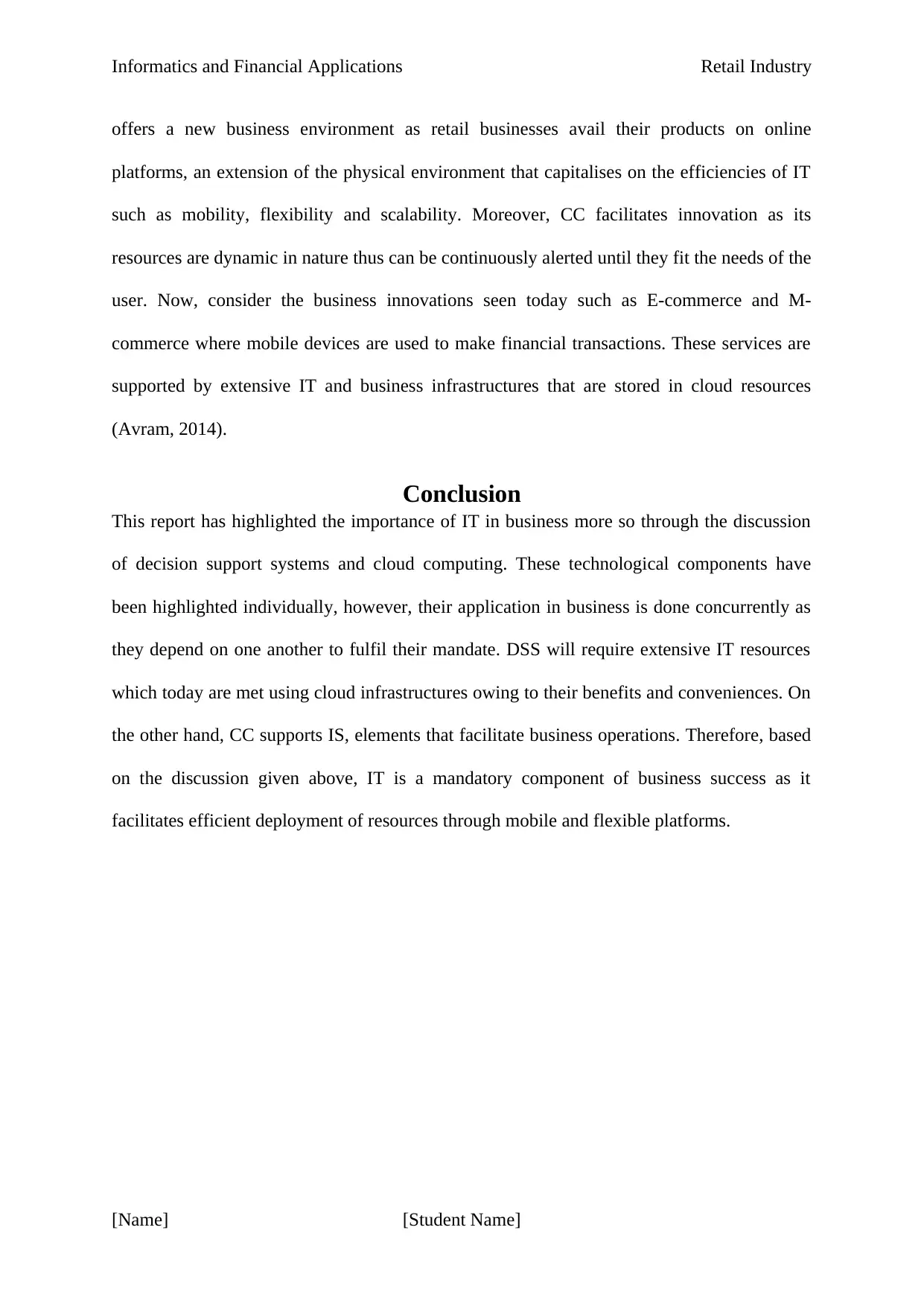
Informatics and Financial Applications Retail Industry
offers a new business environment as retail businesses avail their products on online
platforms, an extension of the physical environment that capitalises on the efficiencies of IT
such as mobility, flexibility and scalability. Moreover, CC facilitates innovation as its
resources are dynamic in nature thus can be continuously alerted until they fit the needs of the
user. Now, consider the business innovations seen today such as E-commerce and M-
commerce where mobile devices are used to make financial transactions. These services are
supported by extensive IT and business infrastructures that are stored in cloud resources
(Avram, 2014).
Conclusion
This report has highlighted the importance of IT in business more so through the discussion
of decision support systems and cloud computing. These technological components have
been highlighted individually, however, their application in business is done concurrently as
they depend on one another to fulfil their mandate. DSS will require extensive IT resources
which today are met using cloud infrastructures owing to their benefits and conveniences. On
the other hand, CC supports IS, elements that facilitate business operations. Therefore, based
on the discussion given above, IT is a mandatory component of business success as it
facilitates efficient deployment of resources through mobile and flexible platforms.
[Name] [Student Name]
offers a new business environment as retail businesses avail their products on online
platforms, an extension of the physical environment that capitalises on the efficiencies of IT
such as mobility, flexibility and scalability. Moreover, CC facilitates innovation as its
resources are dynamic in nature thus can be continuously alerted until they fit the needs of the
user. Now, consider the business innovations seen today such as E-commerce and M-
commerce where mobile devices are used to make financial transactions. These services are
supported by extensive IT and business infrastructures that are stored in cloud resources
(Avram, 2014).
Conclusion
This report has highlighted the importance of IT in business more so through the discussion
of decision support systems and cloud computing. These technological components have
been highlighted individually, however, their application in business is done concurrently as
they depend on one another to fulfil their mandate. DSS will require extensive IT resources
which today are met using cloud infrastructures owing to their benefits and conveniences. On
the other hand, CC supports IS, elements that facilitate business operations. Therefore, based
on the discussion given above, IT is a mandatory component of business success as it
facilitates efficient deployment of resources through mobile and flexible platforms.
[Name] [Student Name]
Paraphrase This Document
Need a fresh take? Get an instant paraphrase of this document with our AI Paraphraser
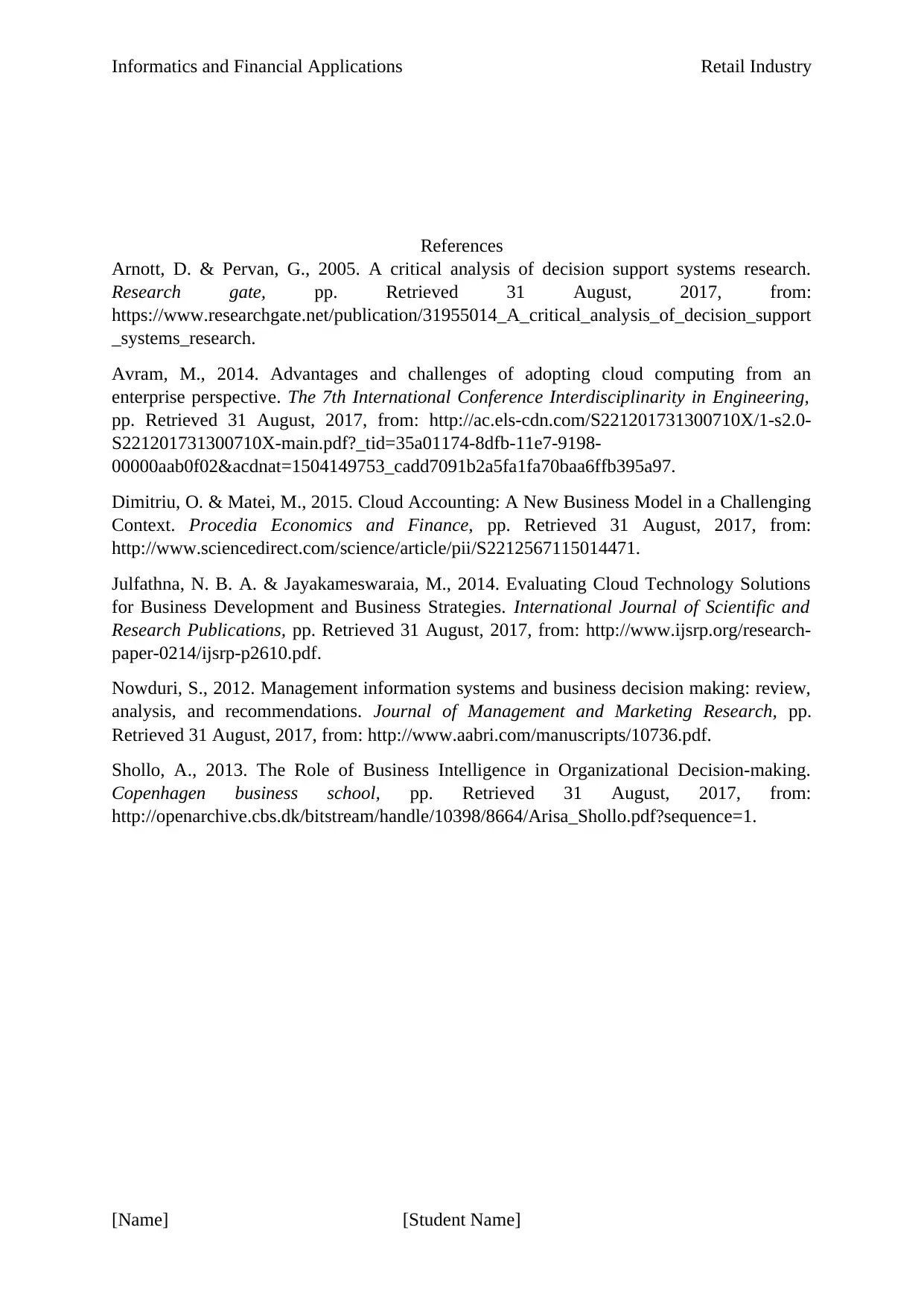
Informatics and Financial Applications Retail Industry
References
Arnott, D. & Pervan, G., 2005. A critical analysis of decision support systems research.
Research gate, pp. Retrieved 31 August, 2017, from:
https://www.researchgate.net/publication/31955014_A_critical_analysis_of_decision_support
_systems_research.
Avram, M., 2014. Advantages and challenges of adopting cloud computing from an
enterprise perspective. The 7th International Conference Interdisciplinarity in Engineering,
pp. Retrieved 31 August, 2017, from: http://ac.els-cdn.com/S221201731300710X/1-s2.0-
S221201731300710X-main.pdf?_tid=35a01174-8dfb-11e7-9198-
00000aab0f02&acdnat=1504149753_cadd7091b2a5fa1fa70baa6ffb395a97.
Dimitriu, O. & Matei, M., 2015. Cloud Accounting: A New Business Model in a Challenging
Context. Procedia Economics and Finance, pp. Retrieved 31 August, 2017, from:
http://www.sciencedirect.com/science/article/pii/S2212567115014471.
Julfathna, N. B. A. & Jayakameswaraia, M., 2014. Evaluating Cloud Technology Solutions
for Business Development and Business Strategies. International Journal of Scientific and
Research Publications, pp. Retrieved 31 August, 2017, from: http://www.ijsrp.org/research-
paper-0214/ijsrp-p2610.pdf.
Nowduri, S., 2012. Management information systems and business decision making: review,
analysis, and recommendations. Journal of Management and Marketing Research, pp.
Retrieved 31 August, 2017, from: http://www.aabri.com/manuscripts/10736.pdf.
Shollo, A., 2013. The Role of Business Intelligence in Organizational Decision-making.
Copenhagen business school, pp. Retrieved 31 August, 2017, from:
http://openarchive.cbs.dk/bitstream/handle/10398/8664/Arisa_Shollo.pdf?sequence=1.
[Name] [Student Name]
References
Arnott, D. & Pervan, G., 2005. A critical analysis of decision support systems research.
Research gate, pp. Retrieved 31 August, 2017, from:
https://www.researchgate.net/publication/31955014_A_critical_analysis_of_decision_support
_systems_research.
Avram, M., 2014. Advantages and challenges of adopting cloud computing from an
enterprise perspective. The 7th International Conference Interdisciplinarity in Engineering,
pp. Retrieved 31 August, 2017, from: http://ac.els-cdn.com/S221201731300710X/1-s2.0-
S221201731300710X-main.pdf?_tid=35a01174-8dfb-11e7-9198-
00000aab0f02&acdnat=1504149753_cadd7091b2a5fa1fa70baa6ffb395a97.
Dimitriu, O. & Matei, M., 2015. Cloud Accounting: A New Business Model in a Challenging
Context. Procedia Economics and Finance, pp. Retrieved 31 August, 2017, from:
http://www.sciencedirect.com/science/article/pii/S2212567115014471.
Julfathna, N. B. A. & Jayakameswaraia, M., 2014. Evaluating Cloud Technology Solutions
for Business Development and Business Strategies. International Journal of Scientific and
Research Publications, pp. Retrieved 31 August, 2017, from: http://www.ijsrp.org/research-
paper-0214/ijsrp-p2610.pdf.
Nowduri, S., 2012. Management information systems and business decision making: review,
analysis, and recommendations. Journal of Management and Marketing Research, pp.
Retrieved 31 August, 2017, from: http://www.aabri.com/manuscripts/10736.pdf.
Shollo, A., 2013. The Role of Business Intelligence in Organizational Decision-making.
Copenhagen business school, pp. Retrieved 31 August, 2017, from:
http://openarchive.cbs.dk/bitstream/handle/10398/8664/Arisa_Shollo.pdf?sequence=1.
[Name] [Student Name]
1 out of 8
Related Documents
Your All-in-One AI-Powered Toolkit for Academic Success.
+13062052269
info@desklib.com
Available 24*7 on WhatsApp / Email
![[object Object]](/_next/static/media/star-bottom.7253800d.svg)
Unlock your academic potential
Copyright © 2020–2025 A2Z Services. All Rights Reserved. Developed and managed by ZUCOL.




